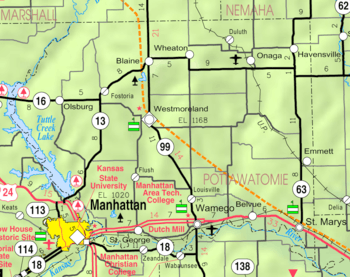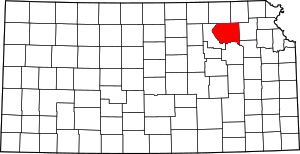Louisville, Kansas
Louisville is a city in Pottawatomie County, Kansas, United States. As of the 2010 census, the city population was 188.[6]
Louisville, Kansas | |
|---|---|
 Location within Pottawatomie County and Kansas | |
 KDOT map of Pottawatomie County (legend) | |
| Coordinates: 39°15′N 96°19′W | |
| Country | United States |
| State | Kansas |
| County | Pottawatomie |
| Founded | 1857 |
| Incorporated | 1870 |
| Named for | Louis Wilson and Louis Vieux |
| Area | |
| • Total | 0.49 sq mi (1.27 km2) |
| • Land | 0.49 sq mi (1.27 km2) |
| • Water | 0 sq mi (0 km2) |
| Elevation | 1,010 ft (310 m) |
| Population | |
| • Total | 188 |
| • Estimate (2016)[3] | 209 |
| • Density | 380/sq mi (150/km2) |
| Time zone | UTC-6 (CST) |
| • Summer (DST) | UTC-5 (CDT) |
| ZIP code | 66450 |
| Area code | 785 |
| FIPS code | 20-42925 [4] |
| GNIS ID | 0476241 [5] |
History
Founded in 1857 by Robert Wilson as Rock Post. The area was once part of the Potawatomi Hunting grounds and a large majority of the settlers were either associated with the Pottawatomie Indian Reservation or commerce on the Oregon Trail.[7] Louisville was named for Robert Wilson's son, Louis, and for Louis Vieux, a successful businessman in the area. The town was a contender for county seat of Pottawatomie County but lost to St. George in 1861 and Westmoreland in 1882.[7]
On November 8, 1875, Louisville was struck by an earthquake.[7] In 1882, with the county seat in Westmoreland and the Union Pacific Railroad built through Wamego, the town's population swiftly declined.
Louis Vieux
Louis Vieux Sr. was a prominent citizen of Louisville who operated a trail crossing across the Vermillion River. He was born in 1809 in Wisconsin to Angelique Roy, a Potawatomi woman, and Jacques Vieux, a Canadian-French trader. Vieux and his wife, Sha-Note, moved first to Cedar Bluffs, Iowa in 1832 until moving to Indianola, Kansas (northwest of Topeka along Soldier Creek) in 1846. Sha-Note died in 1857 and Vieux moved to the Vermillion River near present-day Louisville. Vieux began his trail crossing business and worked as a caller for the U.S. Government working the pay station in St. Mary's and he also served on the tribal council and made trips to Washington, D.C. on behalf of the Pottawatomies. Vieux also signed the treaty that split the Pottawatomies into two separate tribes-the Prairie Band and Citizen Potawatomi Nation. Vieux died in 1872 and left behind a 200-page will leaving half the town of Louisville, all of Belvue and other personal property to his wife and children.
Oregon Trail crossing
About three miles east of Louisville was the Vermillion Crossing of the Oregon Trail operated by Louis Vieux. Vieux is buried in the Vieux Family Cemetery on top of a hill. Nearby, on the banks of the river, is a cholera cemetery from 1849, which is estimated to contain at least fifty graves, although only two stones — both native sandstones — remain. The Louis Vieux Elm Tree is across the river and is estimated to be over 300 years old. The tree had been afflicted with Dutch Elm disease, a lightning strike and vandalism and efforts were taken to protect and shelter the tree's stump. In August 2011, the stump was destroyed by fire.[8] Near the tree are the graves of seven unknown soldiers.
Geography
Louisville is located at 39°15′N 96°19′W (39.251,-96.314),[9] between Wamego and Westmoreland on K-99. According to the United States Census Bureau, the city has a total area of 0.49 square miles (1.27 km2), all of it land.[1]
Demographics
| Historical population | |||
|---|---|---|---|
| Census | Pop. | %± | |
| 1860 | 135 | — | |
| 1870 | 344 | 154.8% | |
| 1880 | 432 | 25.6% | |
| 1890 | 382 | −11.6% | |
| 1900 | 336 | −12.0% | |
| 1910 | 246 | −26.8% | |
| 1920 | 207 | −15.9% | |
| 1930 | 227 | 9.7% | |
| 1940 | 188 | −17.2% | |
| 1950 | 190 | 1.1% | |
| 1960 | 204 | 7.4% | |
| 1970 | 204 | 0.0% | |
| 1980 | 207 | 1.5% | |
| 1990 | 215 | 3.9% | |
| 2000 | 209 | −2.8% | |
| 2010 | 188 | −10.0% | |
| Est. 2016 | 209 | [3] | 11.2% |
| U.S. Decennial Census | |||
Louisville is part of the Manhattan, Kansas Metropolitan Statistical Area.
2010 census
As of the census[2] of 2010, there were 188 people, 78 households, and 39 families residing in the city. The population density was 383.7 inhabitants per square mile (148.1/km2). There were 96 housing units at an average density of 195.9 per square mile (75.6/km2). The racial makeup of the city was 92.0% White, 1.1% Native American, 4.3% from other races, and 2.7% from two or more races. Hispanic or Latino of any race were 5.9% of the population.
There were 78 households of which 29.5% had children under the age of 18 living with them, 38.5% were married couples living together, 10.3% had a female householder with no husband present, 1.3% had a male householder with no wife present, and 50.0% were non-families. 26.9% of all households were made up of individuals and 10.2% had someone living alone who was 65 years of age or older. The average household size was 2.41 and the average family size was 3.18.
The median age in the city was 34.5 years. 22.9% of residents were under the age of 18; 11.7% were between the ages of 18 and 24; 28.7% were from 25 to 44; 26.1% were from 45 to 64; and 10.6% were 65 years of age or older. The gender makeup of the city was 51.1% male and 48.9% female.
2000 census
As of the census[4] of 2000, there were 209 people, 77 households, and 56 families residing in the city. The population density was 427.3 people per square mile (164.7/km²). There were 84 housing units at an average density of 171.7 per square mile (66.2/km²). The racial makeup of the city was 98.56% White, 0.48% from other races, and 0.96% from two or more races. Hispanic or Latino of any race were 1.44% of the population.
There were 77 households out of which 37.7% had children under the age of 18 living with them, 54.5% were married couples living together, 18.2% had a female householder with no husband present, and 26.0% were non-families. 19.5% of all households were made up of individuals and 7.8% had someone living alone who was 65 years of age or older. The average household size was 2.71 and the average family size was 3.09.
In the city, the population was spread out with 29.2% under the age of 18, 8.1% from 18 to 24, 30.1% from 25 to 44, 20.1% from 45 to 64, and 12.4% who were 65 years of age or older. The median age was 35 years. For every 100 females, there were 95.3 males. For every 100 females age 18 and over, there were 97.3 males.
The median income for a household in the city was $35,568, and the median income for a family was $37,045. Males had a median income of $26,250 versus $18,472 for females. The per capita income for the city was $15,741. About 8.9% of families and 12.2% of the population were below the poverty line, including 24.5% of those under the age of eighteen and none of those sixty five or over.
References
- "US Gazetteer files 2010". United States Census Bureau. Archived from the original on 2012-07-02. Retrieved 2012-07-06.
- "U.S. Census website". United States Census Bureau. Retrieved 2012-07-06.
- "Population and Housing Unit Estimates". Retrieved June 9, 2017.
- "U.S. Census website". United States Census Bureau. Retrieved 2008-01-31.
- "US Board on Geographic Names". United States Geological Survey. 2007-10-25. Retrieved 2008-01-31.
- "2010 City Population and Housing Occupancy Status". U.S. Census Bureau. Retrieved December 29, 2011.
- Fitzgerald, Daniel. Faded Dreams: More Ghost Towns of Kansas. Lawrence: U of Kansas P, 1994, 29-33.
- http://cjonline.com/news/2011-08-24/arson-claims-historic-elms-stump
- "US Gazetteer files: 2010, 2000, and 1990". United States Census Bureau. 2011-02-12. Retrieved 2011-04-23.
External links
- City
- Historical
- Schools
- USD 320, local school district
- Maps
- Louisville City Map, KDOT
